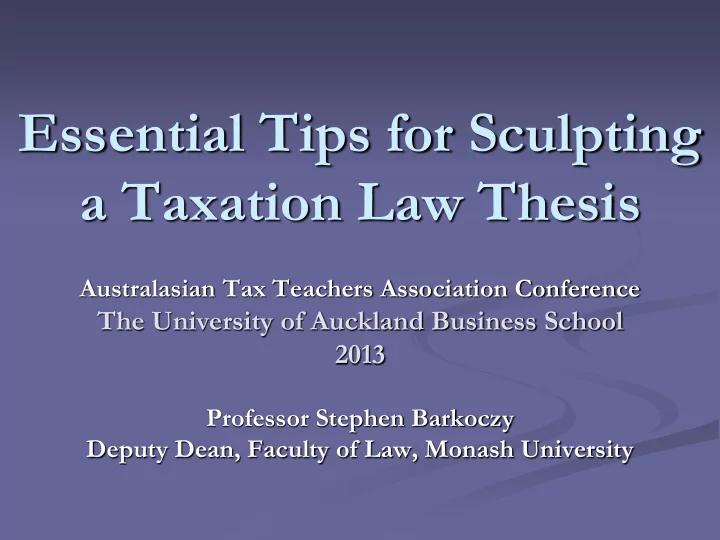

Essential Tips for Sculpting a Taxation Law Thesis Australasian Tax Teachers Association Conference The University of Auckland Business School 2013 Professor Stephen Barkoczy Deputy Dean, Faculty of Law, Monash University
Parts of a thesis CHAPTERS Introduction Contains, background, literature review, thesis, methodology, introduces future chapters and structure Middle chapters Contains main content – each chapter needs to be linked to the other chapters but must also stand alone as a distinct discussion Concluding chapter Identifies conclusions, draws together the thesis, indicates what contribution has been made to the learning in the field Introduction and concluding chapters are the most important and must be closely linked OTHER PARTS OF THESIS Acknowledgements Table of contents Bibliography Glossary Index
Chapter 1 – Introductory matters BACKGROUND AND IMPORTANCE Provide an engaging background and setting for your thesis May be controversial or topical (eg leading judicial quote that highlights legal dilemma) to capture attention of examiner Think multi-disciplinary – consider raising not only legal, but also philosophical, social, economic, political and international issues Identify the key problems or issues in the area of law your thesis will cover (but don’t answer them in Chapter 1) Explain why it is important to do research in the area Explain how others will benefit from your research – highlight social importance, or deficit in the literature LITERATURE REVIEW Identify what has been written in this area in the past Refer to key overseas literature Explain how you will be expanding on this Show breadth of background research undertaken
Chapter 1 – Your thesis EXPLAIN YOUR THESIS A thesis is more than mere “scholarship” – argue don’t just describe State your thesis clearly and unambiguously Examiner needs to know exactly what you are hypothesising Examiner needs to be able to refer back to the statement of hypothesis when reading the other chapters in the thesis “Back of postage stamp” principle “Contain” your thesis Avoid opening a “can of worms”- limit what you will cover Explain why you have limited the scope of your thesis (eg why you are not looking at certain jurisdictions, areas of law etc) NOVEL APPROACH Explain theoretical underpinnings Explain why your thesis is novel or innovative Explain what your thesis will add to the learning in the area Explain whether you will be making recommendations for reform
Chapter 1 – Your thesis (cont) MEHODOLOGY Explain clearly what your methodology is and why your methodology is the best way to proving your thesis Black letter law analysis International comparative analysis Case study analysis Field study analysis Empirical analysis Cross disciplinary analysis PROVING THESIS Briefly describe what each chapter in the thesis will be covering Explain why each chapter has been included in the thesis Explain how each chapter builds on the previous chapter Explain how each chapter will ultimately prove your thesis
Structure and style CHAPTER STRUCTURE Have a clear chapter structure in mind – do not deviate from this Start each chapter with an explanation of why it is in your thesis End each chapter with your conclusions from the chapter and explain how the conclusions will be relied on in subsequent chapters Cross reference throughout chapters LANGUAGE AND STYLE State the obvious clearly and succinctly Avoid padding and being superfluous Avoid colourful and colloquial language Use consistent terminology BE BALANCED IN YOUR VIEWS State both sides to an argument Clearly state what views you adopt and why Make sure you accurately cite all views (respectfully)
Structure and style (cont) AVOID THE MOSAIC THESIS Be selective with quotations Quotations should support your work – they should not be passed off as your work VISUAL EFFECT Consider appropriate use of diagrams, tables and examples Font, quotation, footnote style – be consistent within each style HEADINGS Use clear headings that let the examiner know what you will be covering Use levelled headings that show how sub-headings fit in with main headings Self test: read only the headings and sub-headings to see if they hang together and topics are in the right order FOOTNOTES Pay attention to using appropriate and consistent footnote style Self test: read footnotes separately from the main text
Chapters generally SEPARATE CHAPTERS Examiners read one chapter at a time – they rarely, if ever, read a whole thesis in one go Each chapter should not only read like part of a thesis but as a series of single pieces of work (with connections to other chapters) Writing a thesis as a series of separate chapters will also help with publications on the way ORDER AND CONTENT OF CHAPTERS Check whether chapter order is appropriate – does each chapter logically build on the previous chapter and lead to the next chapter Consider whether it is appropriate to deal with a particular topic within a chapter or as a separate chapter Self test - read only chapter headings and sub-headings – does the thesis hang together?
Final chapter CONCLUSION State your conclusion clearly and unambiguously Establish link with other chapters Self test: when the thesis is finished, read only the first and last chapters and see if the thesis “hangs together” Ask: Have you proved the points you set out to prove in your hypothesis? YOUR CONTRIBUTION Identify what exactly is your contribution to the law Highlight consequences of your work Identify what work still needs to be done in the area Outline where future research may head in this area Highlight where other scholars may build on your thesis
Other matters POTENTIAL EXAMINERS Always bear in mind when writing who they may be – think international Have you referred to their work? How have you referred to their work? CUT-OFF DATE Be aware of ongoing legal developments Think about placing a cut-off date in thesis (state this in Chapter 1) FINAL TOUCHES Check for consistent use of terminology, capitals, italics, bold etc Spell check Font check Page check CRITICAL REVIEW Review by peers in field Review by established researchers who have completed PhDs
Recommend
More recommend